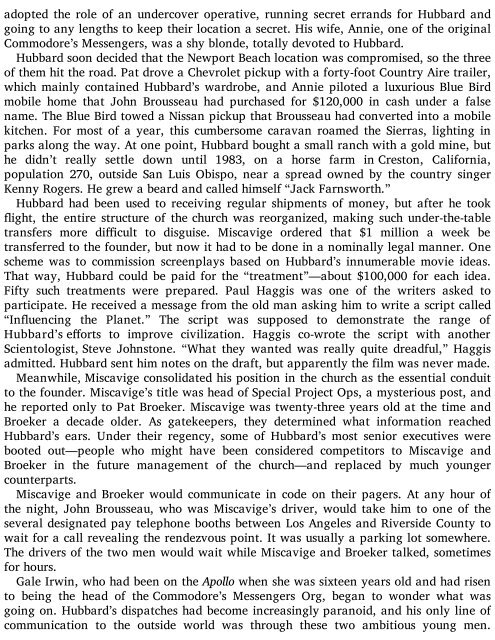going-clear-scientology-hollywood-and-the-prison-of-belief-by-lawrence-wright-2
going-clear-scientology-hollywood-and-the-prison-of-belief-by-lawrence-wright-2
going-clear-scientology-hollywood-and-the-prison-of-belief-by-lawrence-wright-2
Create successful ePaper yourself
Turn your PDF publications into a flip-book with our unique Google optimized e-Paper software.
adopted <strong>the</strong> role <strong>of</strong> an undercover operative, running secret err<strong>and</strong>s for Hubbard <strong>and</strong><br />
<strong>going</strong> to any lengths to keep <strong>the</strong>ir location a secret. His wife, Annie, one <strong>of</strong> <strong>the</strong> original<br />
Commodore’s Messengers, was a shy blonde, totally devoted to Hubbard.<br />
Hubbard soon decided that <strong>the</strong> Newport Beach location was compromised, so <strong>the</strong> three<br />
<strong>of</strong> <strong>the</strong>m hit <strong>the</strong> road. Pat drove a Chevrolet pickup with a forty-foot Country Aire trailer,<br />
which mainly contained Hubbard’s wardrobe, <strong>and</strong> Annie piloted a luxurious Blue Bird<br />
mobile home that John Brousseau had purchased for $120,000 in cash under a false<br />
name. The Blue Bird towed a Nissan pickup that Brousseau had converted into a mobile<br />
kitchen. For most <strong>of</strong> a year, this cumbersome caravan roamed <strong>the</strong> Sierras, lighting in<br />
parks along <strong>the</strong> way. At one point, Hubbard bought a small ranch with a gold mine, but<br />
he didn’t really settle down until 1983, on a horse farm in Creston, California,<br />
population 270, outside San Luis Obispo, near a spread owned <strong>by</strong> <strong>the</strong> country singer<br />
Kenny Rogers. He grew a beard <strong>and</strong> called himself “Jack Farnsworth.”<br />
Hubbard had been used to receiving regular shipments <strong>of</strong> money, but after he took<br />
ight, <strong>the</strong> entire structure <strong>of</strong> <strong>the</strong> church was reorganized, making such under-<strong>the</strong>-table<br />
transfers more dicult to disguise. Miscavige ordered that $1 million a week be<br />
transferred to <strong>the</strong> founder, but now it had to be done in a nominally legal manner. One<br />
scheme was to commission screenplays based on Hubbard’s innumerable movie ideas.<br />
That way, Hubbard could be paid for <strong>the</strong> “treatment”—about $100,000 for each idea.<br />
Fifty such treatments were prepared. Paul Haggis was one <strong>of</strong> <strong>the</strong> writers asked to<br />
participate. He received a message from <strong>the</strong> old man asking him to write a script called<br />
“Inuencing <strong>the</strong> Planet.” The script was supposed to demonstrate <strong>the</strong> range <strong>of</strong><br />
Hubbard’s eorts to improve civilization. Haggis co-wrote <strong>the</strong> script with ano<strong>the</strong>r<br />
Scientologist, Steve Johnstone. “What <strong>the</strong>y wanted was really quite dreadful,” Haggis<br />
admitted. Hubbard sent him notes on <strong>the</strong> draft, but apparently <strong>the</strong> film was never made.<br />
Meanwhile, Miscavige consolidated his position in <strong>the</strong> church as <strong>the</strong> essential conduit<br />
to <strong>the</strong> founder. Miscavige’s title was head <strong>of</strong> Special Project Ops, a mysterious post, <strong>and</strong><br />
he reported only to Pat Broeker. Miscavige was twenty-three years old at <strong>the</strong> time <strong>and</strong><br />
Broeker a decade older. As gatekeepers, <strong>the</strong>y determined what information reached<br />
Hubbard’s ears. Under <strong>the</strong>ir regency, some <strong>of</strong> Hubbard’s most senior executives were<br />
booted out—people who might have been considered competitors to Miscavige <strong>and</strong><br />
Broeker in <strong>the</strong> future management <strong>of</strong> <strong>the</strong> church—<strong>and</strong> replaced <strong>by</strong> much younger<br />
counterparts.<br />
Miscavige <strong>and</strong> Broeker would communicate in code on <strong>the</strong>ir pagers. At any hour <strong>of</strong><br />
<strong>the</strong> night, John Brousseau, who was Miscavige’s driver, would take him to one <strong>of</strong> <strong>the</strong><br />
several designated pay telephone booths between Los Angeles <strong>and</strong> Riverside County to<br />
wait for a call revealing <strong>the</strong> rendezvous point. It was usually a parking lot somewhere.<br />
The drivers <strong>of</strong> <strong>the</strong> two men would wait while Miscavige <strong>and</strong> Broeker talked, sometimes<br />
for hours.<br />
Gale Irwin, who had been on <strong>the</strong> Apollo when she was sixteen years old <strong>and</strong> had risen<br />
to being <strong>the</strong> head <strong>of</strong> <strong>the</strong> Commodore’s Messengers Org, began to wonder what was<br />
<strong>going</strong> on. Hubbard’s dispatches had become increasingly paranoid, <strong>and</strong> his only line <strong>of</strong><br />
communication to <strong>the</strong> outside world was through <strong>the</strong>se two ambitious young men.


